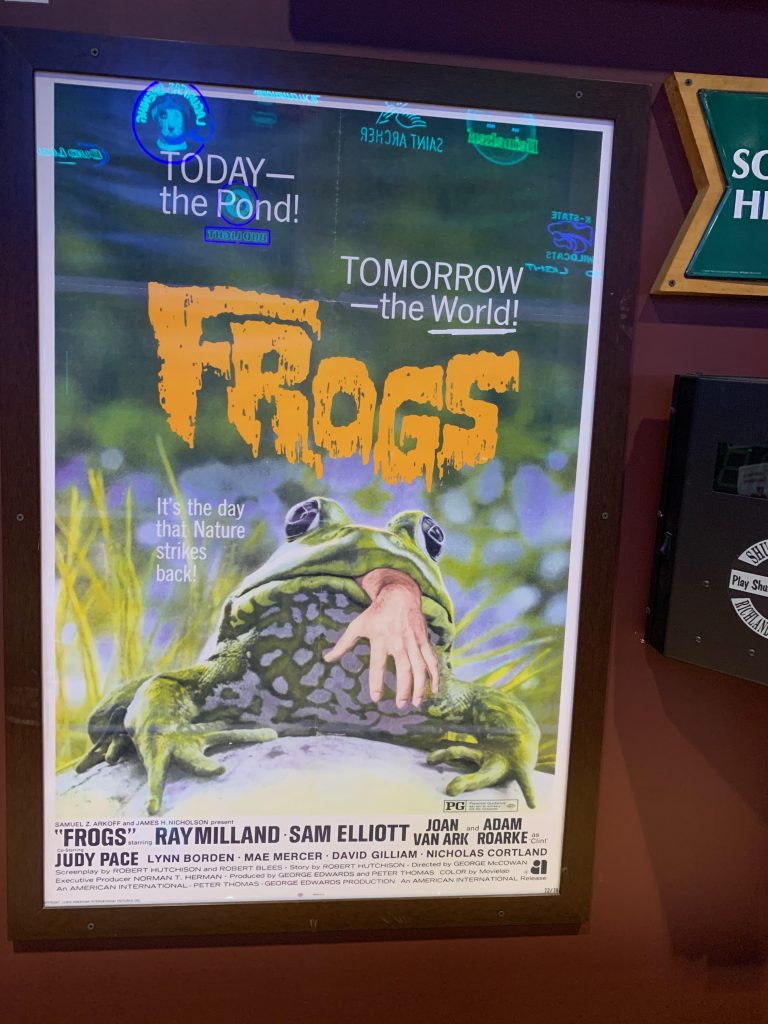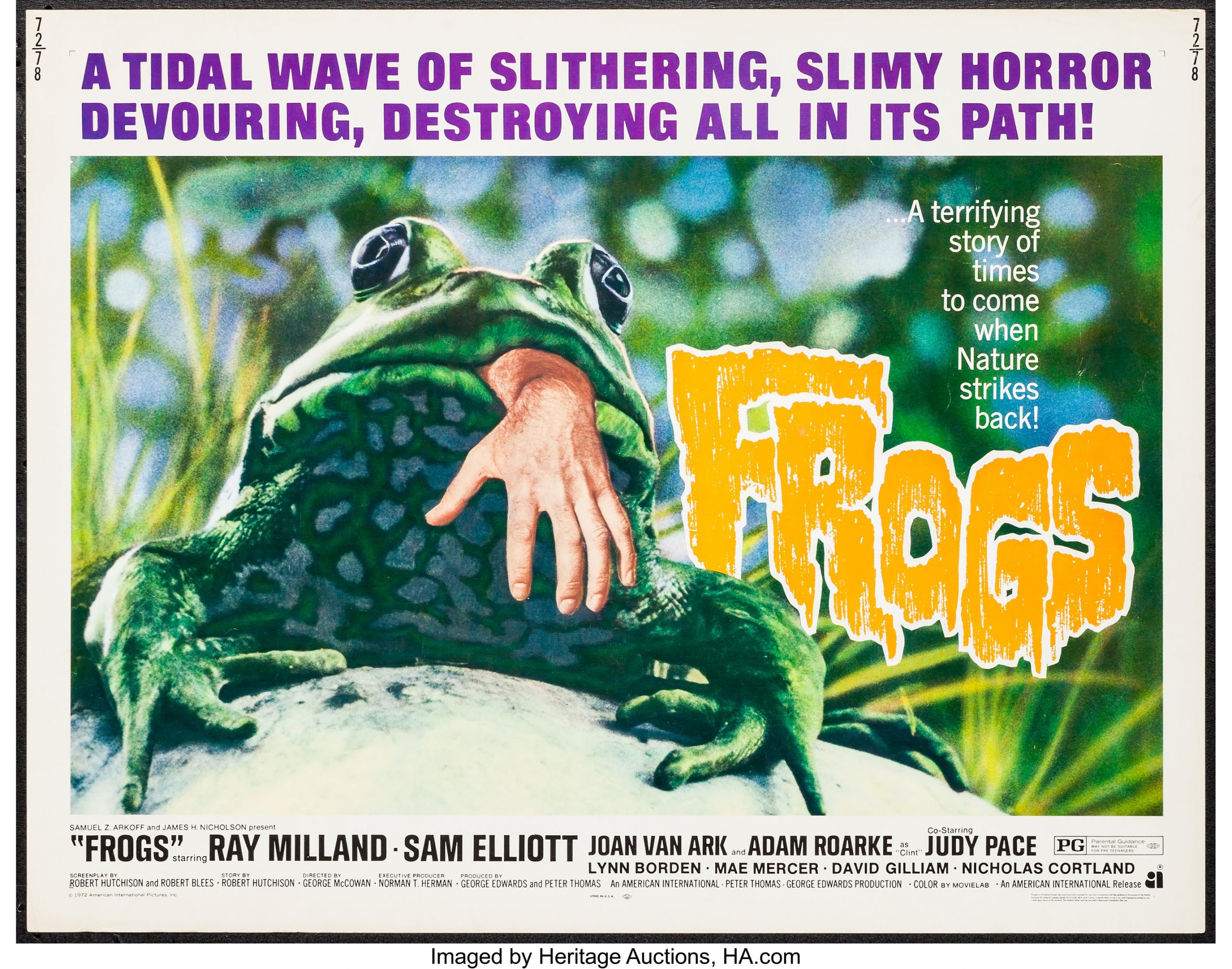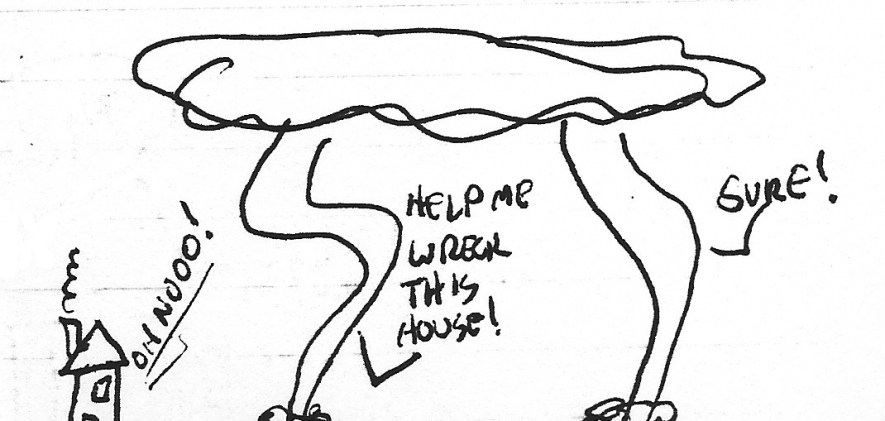 The ZAZ (Zucker, Abrahams, and Zucker) movie Airplane! landed in theaters back in 1980 with the wet PLOP of an overfilled colostomy bag, posing ZAZ as the only contenders who ever got anywhere near Mel Brooks’ brilliant sendups of various film genres (Blazing Saddles, Young Frankenstein, High Anxiety, Silent Movie, Spaceballs, etc.).
The ZAZ (Zucker, Abrahams, and Zucker) movie Airplane! landed in theaters back in 1980 with the wet PLOP of an overfilled colostomy bag, posing ZAZ as the only contenders who ever got anywhere near Mel Brooks’ brilliant sendups of various film genres (Blazing Saddles, Young Frankenstein, High Anxiety, Silent Movie, Spaceballs, etc.).
The ZAZ group’s second film, Top Secret!, apparently caught moviegoers off guard because it was nothing like Airplane!
Airplane! spoofed the wildly popular disaster movies of the ’70s: Airport, The Poseidon Adventure, Earthquake, Towering Inferno, etc.: huge ensemble casts, expensive special effects, predictable-but-enjoyable character arcs.
Airplane! hijacked the genre with well-known actors who had lots of serious films under their belts: Lloyd Bridges, Leslie Neilson, Robert Stack, Ethel Merman–but had them deliver s0me of the funniest performances ever filmed drop-dead seriously, without cracking a smile. But Airplane! also spoofed a specific flavor of disaster movie: An airliner that’s in serious trouble. It’s a great formula for yanking at the heartstrings: Put a bunch of everyday folks trapped together in a plane and see what happens when they all face possible death.
Top Secret! is almost precisely the opposite: It’s a bunch of obscure/unknown actors navigating their way through a whole bunch of movie genres: Top Secret! spoofs WWII flicks like The Great Escape and Force 10 From Navarone; action movies cum musicals like a lot of Elvis Presley movies; and action/spy movies like the James Bond franchise. Rather than an ensemble cast of stars, all the actors were little-known character actors or newbies on their way up (such as Val Kilmer, obviously), with the sole exceptions of Omar Sharif and Peter Cushing in brief bit parts.
YMMV. but I think Top Secret! is still the best film ZAZ ever made. I’ve always loved that they avoided the Tyler Perry/Madea method of making the same film over and over, or even making the same genre of movies (i.e., disaster movies) over and over. But the main reason I love it is because they stuffed so many jokes and sight gags in the film you can hardly breathe, much less swing a dead cat, without being assaulted by another dozen funny things.
I recently stumbled across a Bullshit.IST article ranking every every single joke in Airplane! They listed 178 jokes, and when I read the list I couldn’t think of any jokes in the movie they missed.
But it also raised a question for me: How many jokes are there in Top Secret! ?
It’s always seemed to me that Top Secret! had far more jokes than Airplane!, but I didn’t have any solid numbers supporting my opinion.
Now I do. I present to you my list of all Top Secret! jokes, winks at genres, sight gags, fourth-wall breaks, and any other laugh-inducing moments I could find. So far I’ve cataloged 241 laughs as opposed to 174 for Airplane!
I’m going to post this on Fark.com, so if you think I’ve missed anything or disagree with any of the jokes I’ve listed, please let me know in the Fark discussion thread.
Now, with no further ado, here are the 241 funny bits (so far) I’ve listed from Top Secret!
===================================
- As Agent Cedric fights the German soldier atop the train, the German soldier demolishes a bridge as the train passes underneath.
- A soldier parks a motorcycle, then ties its reins to a rail like it’s a horse.
- The soldier takes off his helmet and the chin strap stays attached to his face.
- When Gen. Streck opens the telegram, the letterhead says “East Germany: Better Government Through Intimidation.”
- The “Find Him and Kill Him” rubber stamp.
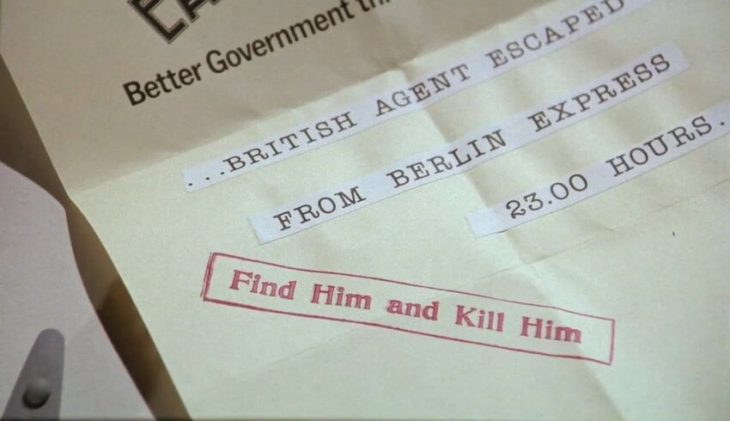
- Major Crumpler says Leonard Bernstein had to cancel his appearance at the cultural festival.[1]
- Teenagers running on the beach carrying surfboards and shotguns.
- A very brief glimpse of a dog pulling a young girl’s swimsuit down that looks like the Coppertone suntan lotion logo.
- Girls on the beach throwing clay pigeons for the surfers—not from behind them, but in front of them and in the line of fire.

Guns ‘n’ Roses ‘n’ Surfin’! - A surfer shoots a beach umbrella between two sunbathers.
- A surfer shoots down a man on a hang glider.
- A girl sits up on the beach, leaving holes in the sand where her breasts were.
- A surfer shoots down a fighter plane.
- The Top 40 tracks list has three Nick Rivers songs (“Skeetin’ U.S.A,” “Skeet City,” and “Your Skeetin’ Heart”), along with several more nonexistent songs, including “Beige Tones” by Procol Harum, “Enough Already!” by The Rolling Stones, “Boy Is She Great” by Aretha Franklin, and “Theme From the Nose,” by Barbra Streisand.
- A surfer shoots off the top of a palm tree.
- Magazine covers and headlines include U.S. News & World Report (“Will Nick Rivers Take Over America?”), and Guns & Bullets (“My Daughter Is Dead, But So Is THE BURGLER”).
- In the crowd of surfers running on the beach there’s an elderly woman in a blue dress.
- Madison Square Garden’s marquee says:
NICK RIVERS
ALSO
STEVIE WONDER
LINDA RONSTADT
AND TIME PERMITTING
FRANK SINATRA - Newspaper headlines: “Rivers to Play East Germany Festival,” “Scientists Prolong Orgasm To Double Figures” and “Meteorite Lands Near Baby.”
- The landscape Nick’s painting from the train is blurred.
- Martin’s newspaper: The Daily Oppressor, with a jackboot logo.
- The Daily Oppressor’s top headline: “Die Festalatin Culturen Eine Big Dealen.”
- The German language tape phrases: “A pen;[2] a table; the pen is on the table; there is sauerkraut in my lederhosen; I want a Schnauzer with my Wiener Schnitzel.”
- Nick assures Martin he’ll be a good cultural ambassador, and that he knows how to say, “Is your daughter 18?” in German.
- When the soldiers and dogs corner a man on the train platform, one of the dogs is a Maltese, not a German Shepherd.
- Right after the man is shot, it’s revealed that the suspicious package he was carrying was just dog biscuits.
- Nick tells Von Horst he put Von Horst’s name on the Montgomery Ward mailing list, which apparently is a dreadful insult or something.
- A soldier slams the compartment door hard enough to shatter the glass.
- When the train platform passes by the window it’s because the platform is moving, not the train.
- When the train starts moving, Martin sees a tree moving along with the train; a commuter runs up behind the tree and jumps on it.
- The map scene shows the train traveling from France to East Germany and stopping in Berlin; then a car leaving the train station, stopping at lights while other cars go by; then the map turns into a Pac-Man game.
- The East German Women’s Olympics team:
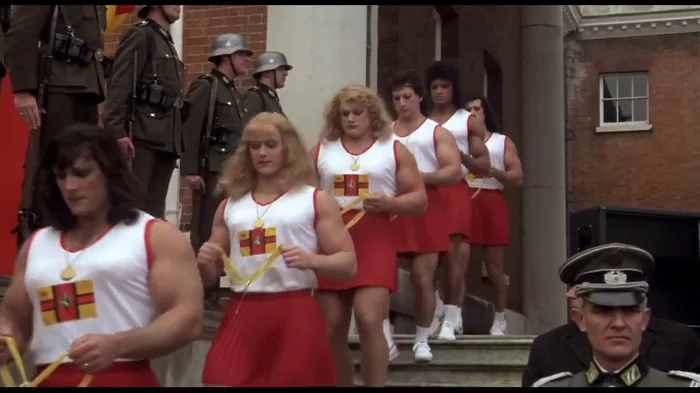
-
-
- The code phrases for Agent Cedric and the Blind Souvenir Vendor:
Agent Cedric: “Do you know any good white basketball players?”
Blind Souvenir Vendor: “There are no good white basketball players.” - Agent Cedric has to pretend he’s looking at the Blind Souvenir Vendor’s practical jokes: A fake flower sprays his face with ink; an exploding cigar blows up in his face; and a can of whipped cream blows up in his face.
- Agent Cedric is ordered to meet The Torch at the Howard Johnson’s on the corner of Der Fuehrer Strasse and Goebbels Platzen.
- Agent Cedric (bending down to scoop something off the sidewalk): “Wait: You dropped your phony dog poo.”
Blind Souvenir Vendor: “What phony dog poo?” - The East German national anthem:
Hail, hail, East Germany
Land of fruit and grape.
Land where you’ll regret
Any try to escape.
No matter if you take a running jump or tunnel under the wall,
Forget it, the guards will kill you, if the electrified fence doesn’t first. - Agent Cedric’s taxi is smashed into a cube with Cedric inside, a la the James Bond movie Goldfinger.
- Nick has dinner at Café Gey Schlüffen, in the Hotel Gey Schlüffen.
- Nick sticks his gum to the underside of a waiter’s tray.
- When the restaurant provides Nick with a suit and tie, they strip him down to his underwear in a foyer in full view of everyone else.
- Nick’s manager’s voice is heard, echoing, as Nick reads his note; it turns out he’s sitting next to Nick speaking through a megaphone.
- Martin orders the ’84 Ripple Blanc for Nick (the movie was released in 1984, so ’84 Ripple Blanc would be mighty nasty).
- More code phrases:
Hillary: “Who do you favor in the Virginia Slims tournament?”
Blind Souvenir Vendor: “In women’s tennis I always root against the heterosexual.” - Hillary gives the Blind Souvenir Vendor a letter that has to be in New York by Tuesday, which turns out to be a Publisher’s Clearinghouse sweepstakes entry.
- The ’84 Ripple Blanc has a soda bottle cap instead of a cork.
- The sommelier hands Nick the ’84 Ripple Blanc cap to smell it like it’s a cork.
- The ’84 Ripple Blanc eats through the glass.

sssssssssss! - As Nick and Hillary dance, the dance gets weirder and weirder.
- Hillary’s uncle escaped from the U.S. in a balloon during the Jimmy Carter presidency.
- “I know a little German; he’s sitting over there.”
- The waiter recommends pork bellies marinated in pig entrails or the roast swine knuckles poached with flaming hog balls.
- Hillary’s name means, “She whose bosoms defy gravity.”
- Nick’s name is just something his dad thought of when he was shaving.
- Hillary: “Some things are better left unsaid.”
Nick: “Like what?”
Hillary: “You know, sometimes when you blow your nose into a tissue and you put it in your purse, then a little while later you have to reach in there for your lipstick or something and your hand gooshes into it and it goes all over…”
Nick: “Okay, okay; you’re right: Some things are better left unsaid.” - Various shots of the orchestra looking confused and playing a mile a minute while Nick sings “Tutti Frutti.”

The Devil Went Where? - Three electric guitar players and two saxophone players suddenly appear in front of the orchestra.
- The kitchen staff, including a chef with a meat cleaver and a dead chicken, dancing to the music.
- The piano player puts his foot on the keys like Jerry Lee Lewis and the bass viola player plays on his back with his feet in the air.
- At the end of “Tutti Frutti,” an elderly guitarist wearing a red bandana smashes his guitar and amp.

Take that, The Man! - “Your hog balls, sir.”
- Agent Cedric shows up in Hillary’s hotel room; he’s trapped inside the smashed taxi with his face sticking out of one end and his feet sticking out of the other.
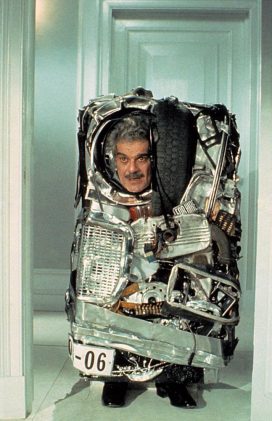
Got any aspirin? - Agent Cedric starts coughing; Hillary opens a can of Hawaiian Punch and pours it into the cube.
- Agent Cedric tries getting into the glove compartment of the smashed taxi; he honks the horn and sets off the wipers and windshield sprayer, both of which hit him in the face.
- Hillary leans over Agent Cedric with her breasts pushing into his face; the taxi’s antenna raises and the horn honks.
- The male ballet dancers have huge protruding bulges in their tights.
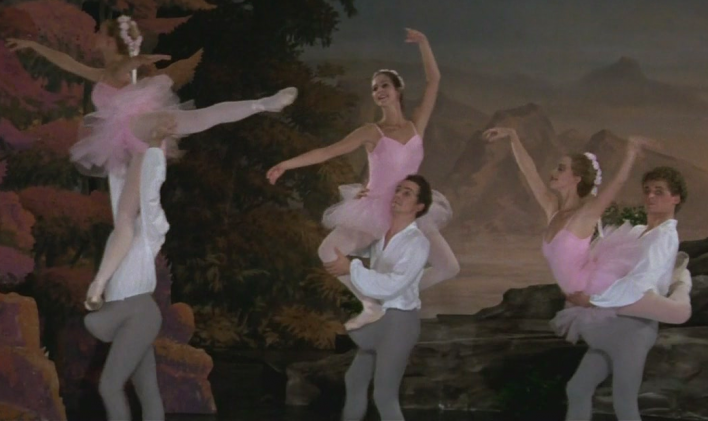
Is that a football in your tights or are you just happy to see me? - A man in Nick’s box seat hands out sodas and hot dogs.
- The male ballet dancers lift the female dancers, who stand on the men’s huge protruding bulges.
- The male ballet dancers stand in two rows so the female dancers can run along their giant protruding bulges.
- Nick’s handprint distorts the policeman’s face even after the policeman pushes him away.
- When the policeman falls into the audience, a male ballet dancer misses a cue; a girl sails over his head with a scream and loudly crashes offscreen.
- In the audience a man gets his face stuck in between a woman’s thighs.
- Janitor closet with a janitor standing inside.
- The Prop Room is full of propellers.
- When Hillary looks down from the balcony at the traffic below, it’s miniature cars with mice causing traffic accidents.
- When police try to get into the Prop Room a propeller is blocking the door.
- Nick scratches the 20th hash mark on his cell wall and tells Martin he’s been locked up for 20 minutes.
- Martin: “I’ve tried everything: The embassy, the German government; the consulate; I even talked to the UN ambassador. It’s no use: I just can’t bring my wife to orgasm.”
- Nick gives Martin a box labeled “Anal Intruder,” which contains a small jackhammer and several attachments.
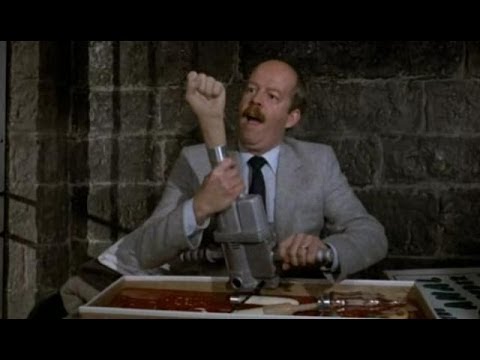
Comedy is not pretty. - Nick’s cell has a food processor on a shelf above the sink.
- The Priest at Nick’s execution: “In nomine Patris, et Filii, et Spiritus Sancti, Omni Gallia divisa est in tres partes, Corpus delecti, Quid pro quo, Veni, vidi, vici, Nolo contendere, Habeas corpus, Rick Dureus, Ipso facto, Pro forma, Pari-passu, Hic, hec, hoc, Huius, huius, huius, E pluribus unum, Ouriyay oingay ootay etgay iedfray in the airchay, Tempus fugit, Caveat emptor, Coitus interruptus, Mitzi Gaynor ad nauseam, Amen.”[3]
- The guards execute the Priest, not Nick.
- Gen. Streck (talking on the phone): “What is the condition of Sergeant Kruger? Yes, I see. Very well, let me know if there is any change in his condition.” (Hangs up.) “He’s dead.”
- Nick’s torturers: Bruno, who is almost blind and has to operate wholly by touch; Klaus, a moron who knows only what he reads in the New York Post.
- Klaus is holding a copy of the New York Post with a headline reading “Maniac Stalks Olivia Newton John.”
- Gen. Streck tells Nick that Martin didn’t know Germany has 220-volt current instead of 110-volt current; Von Horst holds up the damaged, smoking Anal Intruder jackhammer.
- Gen. Streck: “He was found in his hotel room impaled on a large electrical device. Our surgeons did what they could, but it took them two hours just to get the smile off his face.”
- When Nick spits at Gen. Streck there’s a shot of the spit flying clear across the room.
- Nick dreams he’s back in high school and has missed his final chemistry exam; he runs away, saying, “Oh no—I’m back in school!” When he wakes up to find Bruno and Klaus are whipping him, he smiles and says, “Thank God!”
- Gen. Streck is reading Herman Goering’s Workout Book.
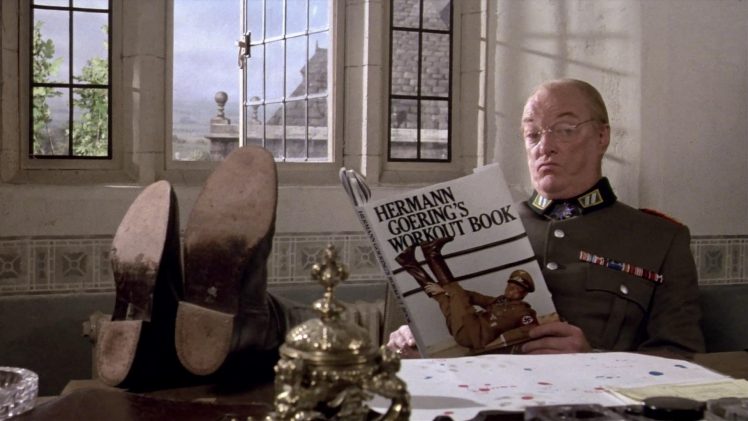
I don’t judge. - Von Horst: He won’t break. They’ve tried everything. Do you want me to bring out the LeRoy Neiman paintings?”
Gen. Streck: “No; we cannot risk violating the Geneva Convention.” - Gen. Streck’s feet stay propped up on his desk when he stands up.
- As Bruno and Klaus drag Nick down a hallway, Bruno bumps into the wall and wanders away.
- When Nick tries to escape his cell, he finds a crowbar sitting on the toilet.
- Nick crawls into a vent, then slides back into the cell from a different vent.
- Nick crawls into a third vent, then finds himself in the medicine cabinet, then the toilet. He finally slides out of a vent in Dr. Flammond’s lab.
- Dr. Flammond: “A year ago, I was close to perfecting the first magnetic desalinization process so revolutionary, it was capable of removing the salt from over 500 million gallons of seawater a day. Do you realize what that could mean to the starving nations of the earth?”
Nick: “Wow! They’d have enough salt to last forever!” - Dr. Flammond: “Then one night, the secret police broke into my house, tore me from my family, ransacked my laboratory, and brought me to this dungeon.”
Nick: “That sucks!” - Dr. Flammond: “If they find out you’ve seen this your life will be worth less than a truckload of dead rats in a tampon factory!”[4]
- When Von Horst is trying to call the firing squad that’s about to shoot Nick, an old woman using a walker very slowly is approaching the ringing phone, spoofing a popular commercial at the time.

I’m coming! I’m coming! - The audience at Nick’s concert holds up signs reading “Velcome Neek.”
- As Nick sings and approaches the edge of the stage, his microphone stand gets longer and longer.

- Nick throws his underwear at the girls in the audience (as opposed to women throwing their underwear at Elvis or Tom Jones).
- Nick pulls a girl out of the audience and sings to her; she faints and Nick lets her crash down on the stage.
- Dyan Cannon is licking her lips at Nick from the audience.
- Nick’s backup singers have to restrain him from committing suicide by hanging himself, sticking his head in an oven, and lying down on a railroad track.
- Hillary rescues Nick by using a suspended guitar to lift him off the stage.
- Nick yells at a bunch of parked bicycles to scare them away, as if they were horses in a Western.
- Streck’s carrier pigeon has a leather flying helmet and a tiny briefcase to hold its messages.
- Hillary tells Nick she once taught a course on Black History in the University of Blaupunkt.
- Hillary’s picture of her father shows him waterskiing with a woman on his shoulders.
- When Hillary and Nick are kissing in the park there’s a large statue of a pigeon behind them, which gets peed and pooped on by people who fly in.
- The pigeon statue poops a huge poop too.
- The entire Swedish bookstore scene is filmed backwards.
- The Swedish bookstore owner’s left eye stays huge after he stops looking through the magnifying glass.
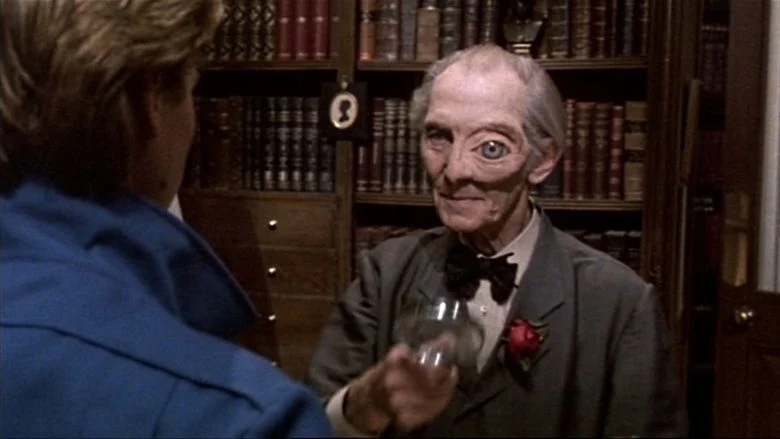
What has been seen cannot be unseen. - The Swedish bookstore owner’s glasses also have a huge left lens.
- Hillary tells Nick it’s okay if he couldn’t get it up, but it turns out she’s reading a book to him.
- Hillary tells Nick her story about being stranded on an island with Nigel, spoofing Blue Lagoon.
- Nigel appears to be spearing a fish, then throws bananas to Hillary.
- Hillary takes oranges off a tree and puts them in a bamboo shopping cart.
- Hillary and Nigel’s house was held together with dried seaweed and snot.
- Their house has a remote-controlled garage door and a mailbox in the front yard.
- Their tropical island is affected by Santa Ana Winds?
- A long, slow pan of Hillary and Nigel kissing on the beach shows many extra hands, feet, and other body parts.
- Nick became an orphan when he got separated from his mother at a department store and she never came back for him.
- The store had a semi-annual Lincoln’s birthday sale.
- And a pre-teen maternity department.
- When Nick plays the commercial jingle he’s just waving his hand around in front of the guitar.
- Nick’s Macy’s song:
Are you lonesome tonight?
Is your kitchen a sight?
Is your wardrobe all rundown and bare?
Is your lipstick all smeared?
Are your stockings not sheer?
Do they make your legs show all your hair?
Do the tears on your pillow roll down as you turn?
Do they short out the blanket and make the sheets burn?
Is your heart filled with pain?
Will you come back again?
Shop at Macy’s and love me tonight! - Nick and Hillary embrace and smash the guitar between them.

Paging Pete Townshend! - Nick and Hillary, kissing and groping each other, roll left to right across the floor past a fireplace, then past another identical fireplace.
- Nick and Hillary are hiding under a pile of hay in a horse-drawn wagon while we hear someone singing part of an opera in German. As the wagon comes closer we see the horse, not the wagon driver, is doing the singing.
- When the horse starts coughing, Hillary asks the driver if the horse is all right. The wagon driver says, “He caught a cold the other day, and he’s just a little hoarse.” (rimshot!)
- As the wagon leaves the horse starts singing “A Hard Day’s Night.”
- Nick: “Is this the potato farm?”
Albert Potato: “Yes; I am Albert Potato.” - Albert Potato opens the peephole at the top of the door, then closes the peephole; when he opens the door, he’s about 4 feet tall.
- As we pan over the French Resistance, most are pointing guns at Nick and Hillary, but one is pointing a cannon; another has a leather vest with numerous throwing knives and the next is wearing a vest loaded with silverware (he’s brandishing a soup ladle).
- When Nigel appears, he’s wearing a loincloth and a cuttlefish necklace, and he’s glistening with oil.
- Hillary grabs a tape measure and measures Nigel’s bicep (he helpfully flexes it); then as Nigel talks to Nick, she stands up staring in awe at the measuring tape, having clearly just measured his tallywhacker.
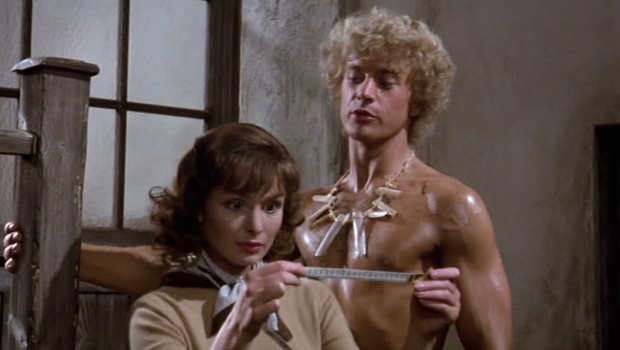
Jackpot! - The French Resistance members’ names: Du Quois, Chevalier, Montage, Detente, Avant-Garde, Déjà Vu, Croissant, Soufflé, Escargot, Latrine, and Chocolate Mousse.[5]
- When Déjà Vu is introduced, he says, “Have we not met before, monsieur?”[6]
- Chocolate Mousse is smoking a cigar; when he’s introduced he eats the cigar like it’s a pretzel stick.
- As Nigel orders the men to prepare for action they excitedly toss around irrelevant French phrases (“Arc de Triomph!”, “Cordon Bleu!”, “Zut alors!”, etc.)
- Hillary: “Nick, I want to explain…”
Nick: “What’s there to explain?”
Hillary: “But I just want to say that…”
Nick: “Look, Hillary: I’m not the first guy who fell in love with a woman that he met at a restaurant who turned out to be the daughter of a kidnapped scientist, only to lose her to her childhood lover who she last saw on a deserted island, who then turned out fifteen years later to be the leader of the French underground.”
Hillary: “I know. It all sounds like some bad movie.”
(They both freeze, then very slowly turn to look at the camera).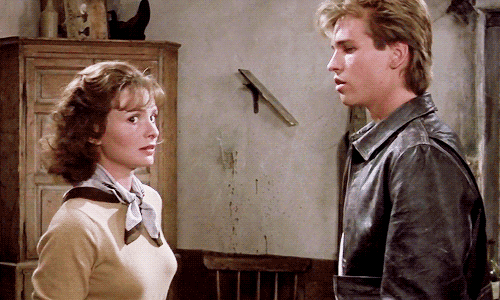
The horror, the horror. - Nigel: “Come, my darling. Let me show you what I’ve done with the fallout shelter.”
- Chocolate Mousse uses a powder horn to pour powder in the barrel of a machine gun.
- Déjà Vu is packing a knapsack with a bottle of Head & Shoulders shampoo, Pepto Bismol, a hair dryer, and a baseball and baseball glove.
- Déjà Vu: “Do not take it so hard, Nick. Life is filled with its little miseries. Each of us, in his own way, must learn to deal with adversity in a mature and adult fashion.” He sneezes into his hands, looks at his hands, then screams and leaps through a window.
- Nick (picking up a bottle from the table): “Mind if I have a swig of this?”
Chocolate Mousse: “Go right ahead!”
Nick (takes a swig, then chokes and spits it out): “What the hell is this stuff?”
Chocolate Mousse: “Gasoline!” (He laughs and drinks from the bottle). - As Hillary and Nigel put their clothes back on in the fallout shelter, Nigel describes how he was picked up by a freight ship and the sailors sexually abused him.
Hillary: “It must have been awful!” (she embraces Nigel).
Nigel smirks at the camera. - Latrine, wounded, staggers in: “We never had a chance—it was a slaughter!” (the running gag here is that Latrine keeps staggering in wounded, and someone yells, “Latrine!”)
Déjà Vu: “We must put a stop to these afternoon football games!” - They scatter as the German army attacks the farmhouse. Three men are playing foosball; one stops to update the score before they scatter.
- The men run to the right, then to the left, then stop to tap dance.
- Du Quois backs up against a wall next to a window; Déjà Vu backs up against the window until Du Quois grabs him and pulls him away.

- Nigel looks out a six-paned window, then breaks the single unbroken pane before shooting.
- Déjà Vu bends his pistol’s barrel trying to break a windowpane.
- Chocolate Mousse shoots a cannon while holding it under one arm.
- Albert Potato is too short to see out the window, so he jumps up repeatedly to shoot.
- Déjà Vu takes a sledgehammer to the window; the hammer breaks into pieces.
- Nick and a German soldier play Tic-Tac-Toe by shooting X’s and O’s in window panes.

- A grenade lands in the middle of the floor; as Du Quois jumps on it, explosions throw four other men out windows and into the ceiling.[7]
- German soldiers crash through the door and start fighting the Resistance hand-to-hand. We cut to Chocolate Mousse shooting erratically at them with a machine gun, then cut back to the Resistance standing next to a pile of dead German soldiers.
Du Quois: “Nice shooting!” - When the Resistance meets in Der Pizza Haus, Déjà Vu and Du Quois hang their guns on a coat stand.
- Chocolate Mousse is holding his Tommy Gun at the table.
- Der Pizza Haus has a Hitler clock.
- Du Quois: “Well, Monsieur Rivers. It seems that you have become, how do you say, indispensable?”
Nick: “Indispensable.”
Du Quois: “That’s what I thought.” - People in the background pick up slices from a pizza, stretching cheese all over the room without breaking free of the pizza.
- Latrine (as usual, staggering in and wounded) slams Streck’s dead carrier pigeon down on the table: “A traitor in our midst!”
Déjà Vu (looking at the pigeon): “Well done, Latrine! I see you have dealt with him appropriately!”
Du Quois (opening the bird’s tiny briefcase): “Not the bird, you fool; this is a carrier pigeon on its way to German headquarters!” - Nick (when two teenagers ask him if he’s Nick Rivers): “You must have me confused with someone else. I’m Mel Torme.”
Du Quois: “That was close!” - Nigel: “How do we know he’s not Mel Torme?”
- Nick spins on a throw rug until it drills a hole in the floor, then re-enters by the front door.
- Déjà Vu knocks a milkshake off the table and into Du Quois’ lap.
- Nick runs up a wall and does a backflip.
- As Nick sings “Straighten it out!” the bartender takes off his toupee, spins it, and puts it back on.
- Two guys standing on a table are spinning their girlfriends around like they’re dead cats.
- Albert Potato (whose head’s down at the level of the table): “This is not Mel Torme.”
- As the Resistance jumps out of the plane there’s a U‑Haul sign painted on the side.
- Déjà Vu’s holding a Duty Free bag as he jumps.
- Hillary (as Nick drifts by her on his parachute): “Oh Nick!”
Nick (raising back up): “Yes?” - Hillary (still parachuting) turns away from Nick; Nick (also still parachuting) approaches her from behind and touches her shoulder.
- As Nick and Hillary (both still parachuting) embrace and kiss, a blazing romantic fireplace appears behind them on its own parachute.
- As the Resistance scouts the prison, a cricket gets louder and louder until Chocolate Mousse smashes it with a giant mallet.
- As Nigel looks at the prison with binoculars, a herd of cows step over the edge of the lenses and appear to be walking inside the binoculars.
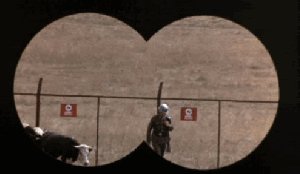
- As Nigel draws the plan with a stick in the dirt, miniature trees, cows, soldiers, a fence, the prison, and a model train appear.
- Nigel insists upon wearing the back half of the cow costume; Du Quois says, “Fine; be an asshole!”
- The cow costume is a real cow, wearing boots, with spots painted on it.
- Du Quois moos from inside the costume with a French accent: “Mieu!”
- A soldier whips the cow and Nigel yells, “Ouch!”
- Nigel groans with pleasure as a calf suckles the cow costume’s udders.
- Leaves rustle and crunch as Nick, Chocolate Mouse, and Déjà Vu walk through the woods; Nick shushes Chocolate Mousse and Déjà Vu and they’re all abruptly silent.
- When Déjà Vu checks the time, his watch is as big as a pie plate.
- The cow puts on a stethoscope to pick the lock on the generator shed.
- The cow takes a drag on a cigarette.
- The switch to cut the power for the electric fence is labeled Das Fencen Switchen.
- As Nick crawls under the fence he sees a soldier standing in the way, but it’s just a pair of empty boots.

- Chocolate Mousse throws a grappling hook straight up; when it starts to fall, Chocolate Mousse, Nick, and Déjà Vu scatter, screaming.
- When Chocolate Mousse throws the grappling hook again, it snags Déjà Vu’s shirt and flings him up the side of the prison.
- As Déjà Vu clings to the edge of the wall, Nick and Chocolate Mousse climb up and over and Déjà Vu, stepping on his head and hands.
- Chocolate Mousse punches a soldier, who goes over the wall and shatters like pottery when he hits the ground.
- A guard on the wall walks by, clueless, as Déjà Vu and another guard fight noisily in the courtyard below.
- Déjà Vu and the guard continue fighting; Chocolate Mousse tag-teams Déjà Vu and steps into a wrestling ring made with barbed wire.
- Chocolate Mousse takes the guard out with WWE moves, yelling, “Vive le France!”
- As Déjà Vu and Chocolate Mousse, disguised as guards, goosestep down the hall, their boots fly off.
- A bull notices Nigel and Du Quois walking by in the cow costume and pursues them while we hear the theme from Jaws.
- The bull mounts the cow costume and Nigel screams.
- Nick (opening the cell door): “Dr. Flammond! Come on; we’re taking you out of here.”
Dr. Flammond (piling dirt on the floor with a spoon): “How ironic; another day and I would have completed my tunnel.”
Nick (looking under the bed and seeing the New Jersey tunnel): “Nice work!” - Hillary takes a handkerchief from Nigel’s coat and sneezes out a pigeon; five more pigeons come out of the coat.
- Nigel’s stiff bowlegged walk after being mounted by the bull.
- When Nigel picks up a rifle leaning against a tree, the tree falls over.
- Nigel: “I was exposed to the works great thinkers: Karl Marx, L. Ron Hubbard, Freddie Laker.”
- Gen. Streck’s giant phone.
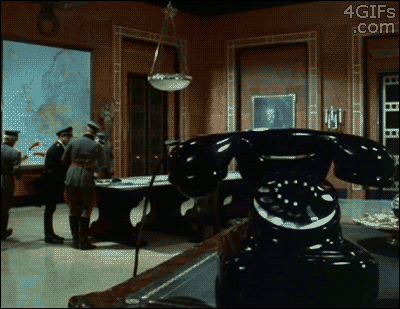
- A guard waves military vehicles along as they race by; when the camera pulls back it’s just a few vehicles driving in a circle.
- Chocolate Mousse: “Where’s the truck?”
Nick: “Where’s Hillary?”
Déjà Vu: “I’m hungry!” - Du Quois: “Nigel made me go back to the meter shed; ordered me to set off the alarm.”
Déjà Vu: “And what does he want us to do now?”
Du Quois: “Nothing, you numbskull; Nigel’s a traitor!” - As German soldiers approach in a truck, Chocolate Mousse holds out his hand and someone offscreen hands him a machine gun like giving a surgeon a scalpel.
- The truck skids out of control as the driver slams on the brakes. As it comes to a stop, a Ford Pinto suddenly appears in front of it. The truck’s bumper barely touches the Pinto’s bumper and the Pinto explodes.[8]
- Du Quois yells, “Latrine!” as Latrine yet again) staggers into the scene, wounded, and collapses on Du Quois, leaning against a log. Then Du Quois pops back up from behnd the log.
- Du Quois: “Nick, whether you make it back or not, that plane must take off with Flammond at 1800 hours.”
Déjà Vu: “That’s why we recommend you be there at least 45 minutes before departure, especially at this time of year.” - Déjà Vu kisses Nick on both cheeks as they depart, leaving large lipstick prints on Nick’s cheeks.
- Déjà Vu (as he and Du Quois, Dr. Flammond, and Chocolate Mousse leave in the still-burning truck, the truck that just exploded the Pinto): “You’ve got to hand it to the Germans: They make great cars!”
- Nick jumps a motorcycle over a barbed-wire fence, a nod to Steve McQueen in The Great Escape.
- Nick winks at the camera, then accelerates as the motorcycle emits the Roadrunner’s “Meep meep!”
- Nick jumps the cycle over six buses.
- Nick stands on the motorcycle like it’s a horse as he jumps on the truck containing Nigel and Hillary.
- As Nick and Nigel battle over Nigel’s pistol and the steering wheel, we also see their hands fighting for control of the truck’s stereo.

Driver picks the music; shotgun shuts their cakehole! - Nick and Nigel fall off the truck, landing in a river. They punch each other, then Nigel hits Nick with a barstool. Nick lands on a table and kicks Nigel as we see they’re in a Western-style saloon at the bottom of the river.
- Nigel crashes into the bar and grabs a pistol; the bartender hits him with a bottle as he shoots at Nick (remember this is all underwater!), who leaps out of the way as a chandelier crashes to the river bed.
- A group of cowboys playing poker duck under the table; one of them leaves his hat still floating where his head was a moment before.
- Nick does a Muhammed Ali-style rope-a-dope, punches Nigel, then grabs Nigel’s nipples and throws him through the saloon’s window, all as the Bonanza theme plays.

Purple nurple! - A girl lying on the bar gurgles “Good-bye” as Nick dusts off his hat and leaves through the (underwater!) saloon’s swinging doors (how do you dust off a hat when you and the hat are both underwater?).
- Hillary zooms down the road on Nick’s motorcycle, her hair flying out behind her. When she stops to look around for Nick, her hair is still pointing behind her.
- When Nick walks out of the river his hair and clothes are dry.
- When Hillary sees Nick, her breasts glow like E.T.s magic finger; they even has the same sound effect.
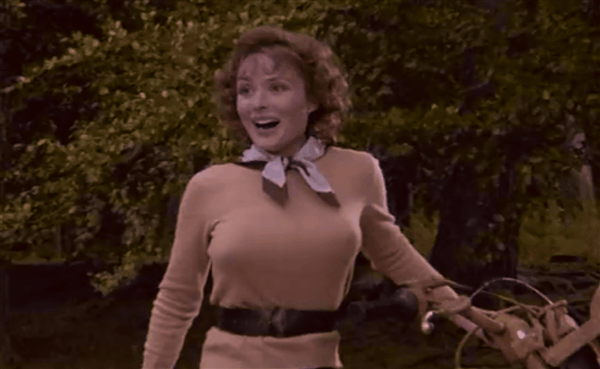
- As the Resistance waits to board their plane, Déjà Vu and Chocolate Mousse use the RAF symbol on the side of the plane to play darts.
- As Hillary jumps off the motorcycle to embrace her father, she pushes Nick and the motorcycle over with a loud crash.
- Hillary: “For as long as a single man is forced to cower under the iron fist of oppression, as long as a child cries out in the night, or an actor can be elected president,[9] we must continue the struggle.”
- Déjà Vu: “Go with Nick. Don’t worry about us. We will hear his music on the Voice of America. We will hear it in the hearts of the people and in elevators everywhere.”
- Hillary: “Things change. People change; hair styles change. Interest rates fluctuate.”
- As Nick and Hillary kiss, their tongues grope around in each other’s cheeks.
- As Hillary hugs everyone and says goodbye, she hugs Scarecrow from The Wizard of Oz.
- Jokes in the credits:
- Focus Puller
- Clapper Loader
- Focus Loader
- Clapper Puller
- Puller Clapper
- Clapper Clapper
- Flipper Flapper
- Haberdasher
- Hey Diddle Diddle: The Cat and the Fiddle
- Foreez: A Jolly Good Fellow
- This Space For Rent
- The code phrases for Agent Cedric and the Blind Souvenir Vendor:
-
Footnotes:
[1] Bernstein’s parents were Jewish and fled Russia before he was born, so the chances that Bernstein would perform in East Germany, to put it mildly, are exceedingly slim.
[2] The German for the terms doesn’t seem to match the English translations; I suspect the German in the entire film is full of jokes but I don’t speak German. If you do, let me know what it says!
[3] Latin translations:
- “In the name of the Father, the Son and the Holy Spirit.”
- “All Gaul is divided into three parts” (the first sentence of Julius Caesar’s book “Caesar’s Commentaries: On The Gallic War and On The Civil War”).
- “Body of the crime” (a legal term referring to concrete evidence of a crime, such as a dead body).
- “Something for something” (colloquially “I’ll do you a favor if you do me a favor in return”).
- “I came, I saw, I conquered.” Also from Caesar, which makes me wonder why they didn’t include “Et tu, Brute?”
- “No contest” (meaning a defendant waives the right to a trial without pleading innocent or guilty).
- “You have the body” (meaning an arrested person must be brought to a judge as soon as possible either to be released or formally charged to remain locked up).
- I have no idea who or what “Rick Dureus” refers to.
- “By the very fact” (meaning something is the inevitable result of something previous).
- “For the sake of form” (something done as a formality).
- “With equal step” (meaning “equal footing” in financial terms).
- “Here, this, this” (the third and fourth conjugation of verbs in Latin).
- “Of this one, of that one” (more Latin conjugations).
- “Out of many, one” (referring to the US when it’s printed on money);
- Pig Latin: “You’re going to get fried in the chair.”
- “Time flies.”
- “Buyer beware.”
- “Sex, interrupted.”
- Mitzi Gaynor. Duh.
- “To nausea,” aka “I’m SICK of this!”
[4] How much is a truckload of dead rats in a tampon factory worth, anyway?
[5] Who is, of course, black.
[6] Déjà Vu is played by Jim Carter, who also plays Carson on Downton Abby.
[7] I’ve seen this movie at least 30 times and I still don’t get this.
[8] When Top Secret! was released, Ford was recalling Pintos because some of them exploded after rear-end collisions.
[9] When Top Secret! was released, Ronald Reagan (a former movie star) was President.
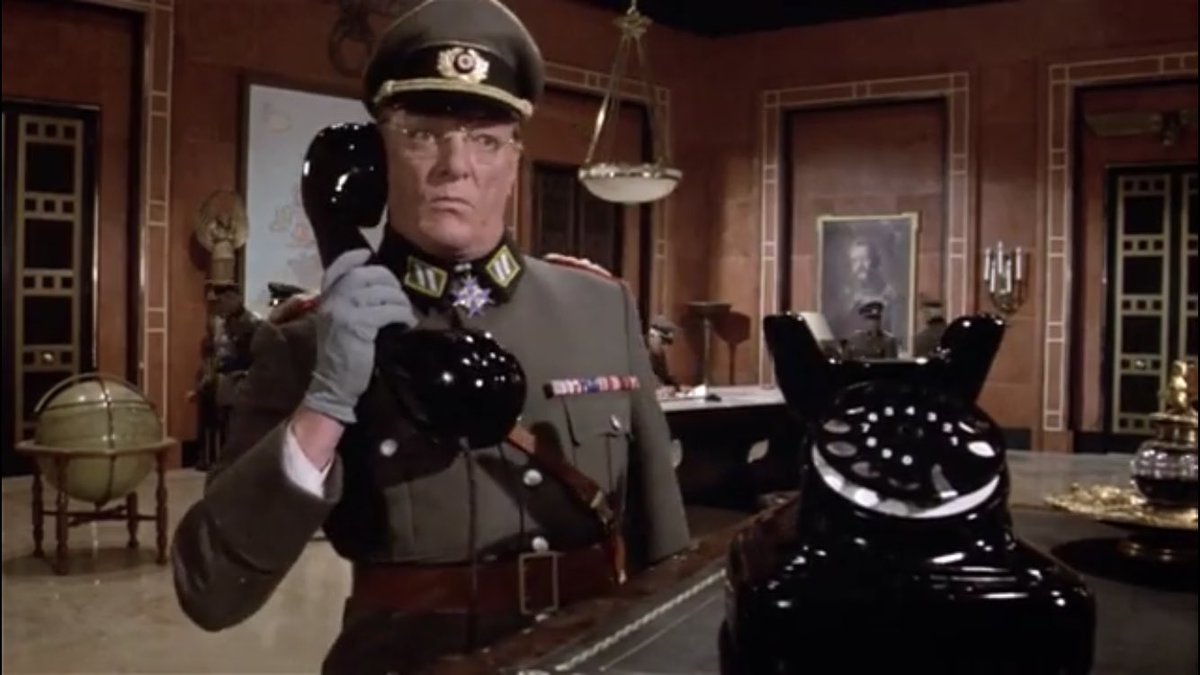
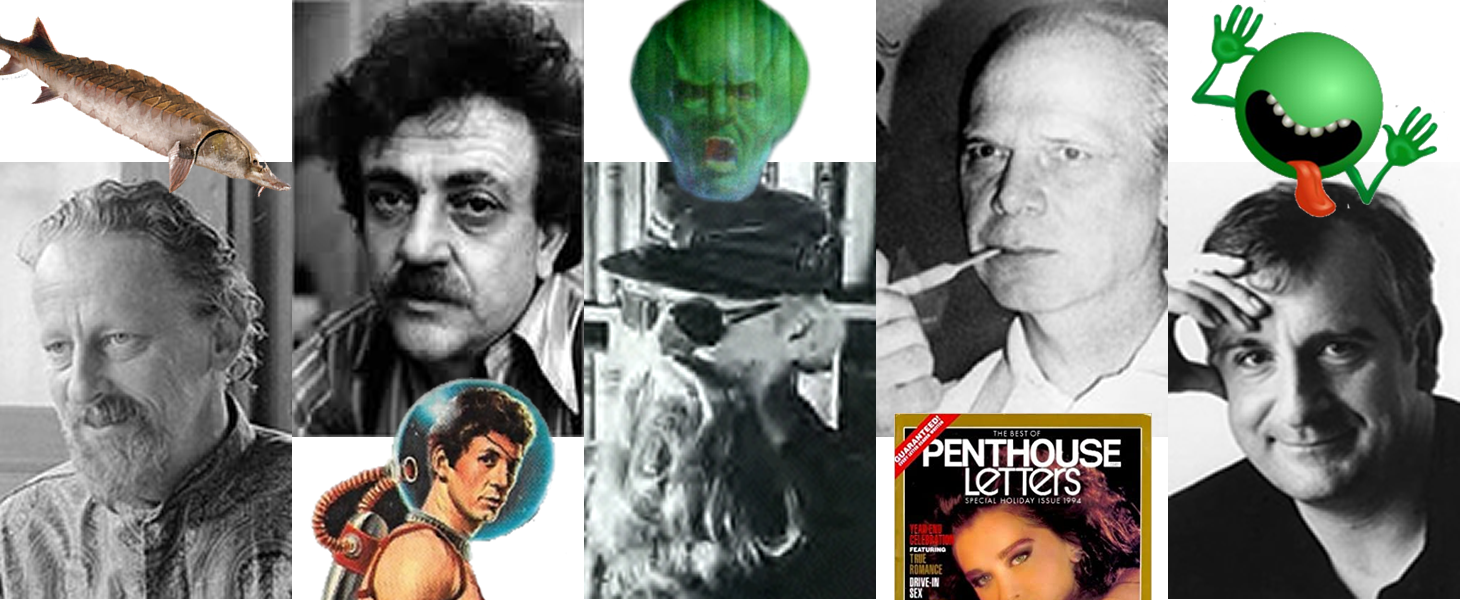
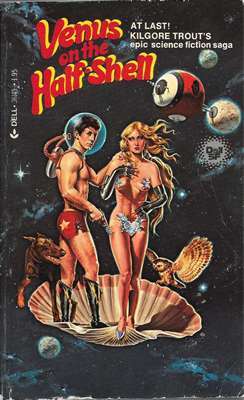
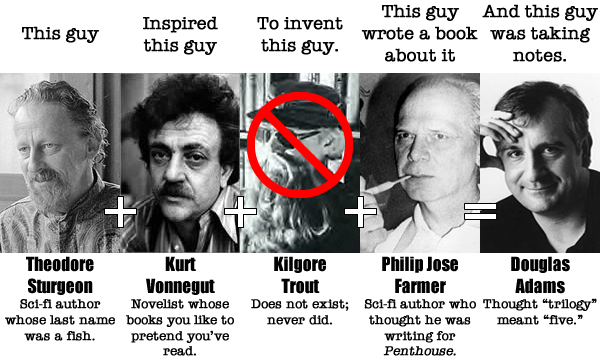
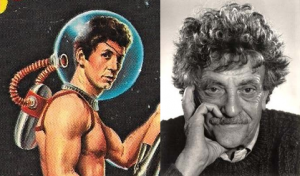


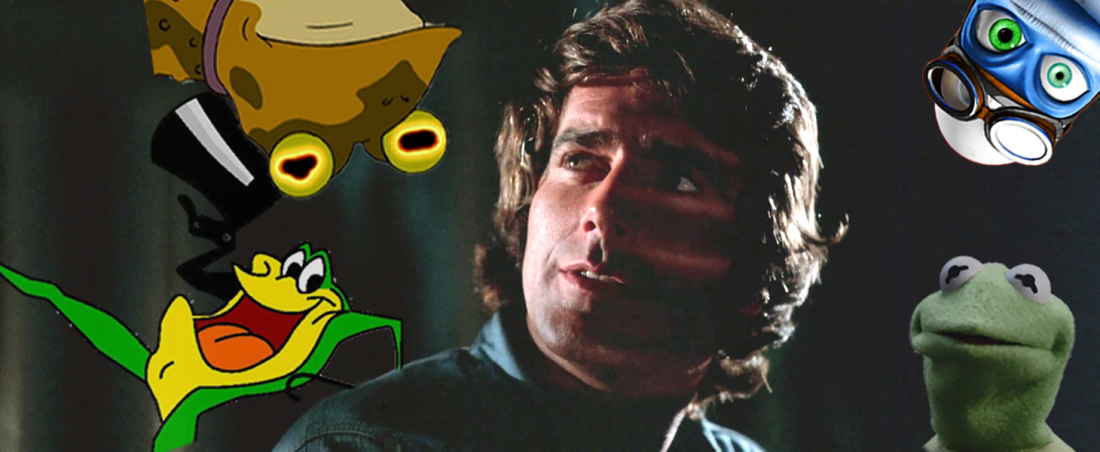
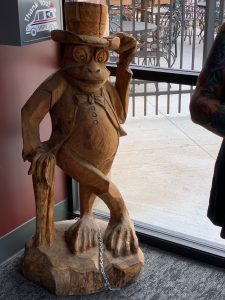
 JBs recently moved to a much larger building, which I was glad to see, what with all the locally owned businesses around the country driven out of business by the pandemic.
JBs recently moved to a much larger building, which I was glad to see, what with all the locally owned businesses around the country driven out of business by the pandemic.